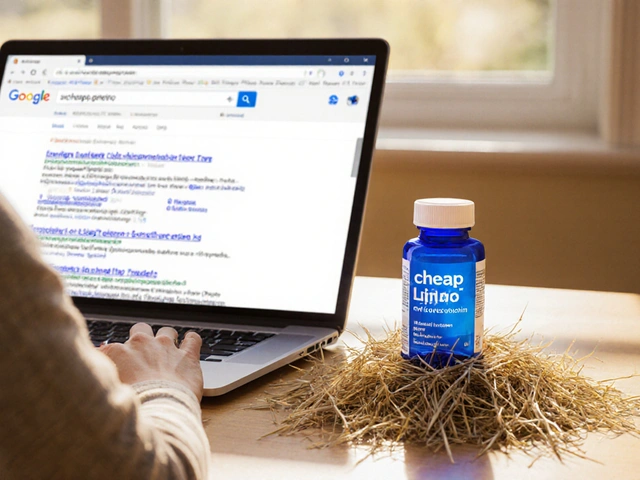2025 Prescription Pricing Transparency: New Laws, Technology, and How to Save on Medications

Ever picked up a prescription, expecting a certain price, and then felt your jaw hit the floor at the register? You’re not alone. Every day, people in Calgary (and really, across North America) scramble to decode the secret math behind drug costs. It isn’t just about what your doctor scribbles on the pad; it’s an entire system of prices that seem to change with the wind. In 2025, big changes are coming—and it's time to unpack what’s happening, what’s worth your attention, and what can genuinely save your wallet from a meltdown.
Why Prescription Pricing Was Always a Mess
If you’ve ever tried comparing the price of insulin at different pharmacies, you know the feeling: no two places ever match up. You might pay $50 at one corner, then cross the street and get quoted $120, all for the same vial. There's a reason for this chaos and, no, you're not going crazy. For decades, drug prices were hidden behind a complex web of manufacturer rebates, pharmacy benefits managers (PBMs), insurance markups, and the kind of negotiations that would make even poker champions sweat. Historically, only insurers and big chains really knew the "real" costs. Consumers? Not so much. That dynamic left everyday folks on the outside, guessing, budgeting in the dark, or—let’s be honest—just going without.
Let’s put some numbers on it. According to a 2023 report from the Canadian Institute for Health Information, Canadians spent $36 billion on prescribed drugs in 2022, with nearly 22% of that coming straight out of consumers’ pockets. The U.S.? Even messier, with Americans shelling out over $400 billion in 2023, much of it opaque and riddled with mark-ups and middlemen fees tucked away in fine print. For years, several watchdog groups tried to shake things up with websites and apps that crowdsource price info, but those got caught up in their own data issues, missing updates, or partnerships that blurred their allegiances.
This system hurt the sick, the elderly, the uninsured, and even well-insured folks stuck with crazy deductibles. If you ever wanted to see a system scream for a shakeup, this was it. The good news? 2025 is looking different, and not just on paper—new rules actually have teeth now.
Game-Changing Regulations: What's New in 2025?
Politicians and health advocates have talked about price transparency for years, but 2025 stands out. Both Canada and the U.S. finally rolled out reforms with real muscle. Here’s what’s actually different this year.
- Mandatory Disclosure: Pharmacies, from giant chains like Shoppers and Walmart to independent stores in Okotoks, must display cash prices for top 100 prescribed medications both in-store and online. That means insulin, statins, antibiotics, blood pressure meds—the essentials—are now front-and-center, with prices updated weekly. No more blank stares or “We’ll check at the counter.”
- PBM Accountability: For the first time, pharmacy benefit managers are forced to disclose their negotiated rates and rebates. This ends the guessing game about why your insurer’s “negotiated price” sometimes comes out higher than paying cash. New oversight boards created at both federal and provincial levels can audit PBMs and fine them if they hide markups.
- Standardized Electronic Price Tools: Every pharmacy must offer an electronic price checker (think a digital kiosk or website portal). You can scan your prescription and instantly see your out-of-pocket price, regardless of insurance status. These tools pull in real-time inventory and insurance contract data.
- Price Alerts for Price Changes: If a medication’s price jumps more than 15% in a given month, pharmacies are required to send out email or text alerts to patients who’ve filled the prescription in the past 6 months. The idea is to prevent that nasty surprise at pick-up.
- Table: Sample Top 10 Drug Price Transparency Requirements – Canada vs. US (2025)
| Rule | Canada | USA |
|---|---|---|
| Mandatory cash price lists | Yes, in all provinces | Yes, federal regulation |
| Real-time insurance cost display | Yes | Yes |
| PBM rebate transparency | Enforced at provincial level | Federal oversight |
| Text/email price jumps | Province-specific | National law |
| Online comparison mandate | Yes | Recommended, not required |
| Patient complaint hotlines | Yes, since January | Yes |
| Pharmacy fines for non-compliance | Up to $50,000 per infraction | Up to $100,000 |
This mix of laws is changing what you see—not just what you pay, but how easy it is to shop smarter. If you haven’t tried looking up prices at multiple local pharmacies, now’s the time. Many stores are scrambling to woo customers, which means more aggressive price-matching and deals. Calgary is already seeing smaller stores advertising “We match any competitor's prescription price — show us proof!” on their windows.

The Tech that’s Making Prices Transparent—Finally
Tech companies finally got tired of waiting for regulators and just built what patients wanted. By spring 2025, every major pharmacy chain and a ton of independents were running new digital dashboards—and holy smokes, they’re a game changer. Here’s what the new wave of pharmacy tech means for the actual process of buying medications:
- Universal Price Checker Apps: Plug in your drug name, dosage, and zip code, and boom—you get immediate price comparisons from every major pharmacy within a 20km radius. The old days of calling four stores are done. Popular apps are now being integrated into Alberta Health and pharmacy websites. Want to see if your blood pressure meds are cheaper in Cochrane or CrossIron Mills? Easy.
- Real-time Inventory Alerts: There’s little worse than driving across town for a "deal," only to discover they’re out of stock. The new pharmacy tech pulls real-time inventory so you know, before you leave the house, exactly who can fill your prescription now at the quoted price.
- Insurance Portal Integration: One of the wildest changes is the deep integration with insurance databases. Now, you can log in via your insurer (e.g., Sun Life, Alberta Blue Cross), and see your actual out-of-pocket cost at different pharmacies—no more guessing about deductibles or tiers. Co-pays and coverage limits show up before you even hit submit.
- Receipt-Level Transparency: Ever wanted to see a breakdown of where your money goes? Now, your receipt at most pharmacies lists what the wholesale price was, the pharmacy’s markup, the PBM’s cut, and how your insurance paid (if you used it). You can check if your discount program actually saved you cash, and finally pull back the curtain on the middlemen.
- AI-Driven Savings Suggestions: A bonus for data nerds—some apps analyze your prescription history and send you suggestions like, “Switching to a 90-day supply could save you $40,” or notify you if a GoodRx alternative program offers a one-time coupon for your refill. Some of these suggestions actually come from patient crowdsourcing, too, so you’re getting real tips from real users.
All this tech isn’t just flashy—it's driving down prices and changing pharmacy loyalty. Pharmacies are seeing that customers will switch for a $10 savings, sometimes less. And as someone who’s lived through years of price mystery, this feels like a victory lap for patients everywhere.
How to Shop Savvy: Real-World Tips to Pay Less in 2025
Navigating the new transparent world is easier, but you’ve got to be strategic. Here are tips—timeless and new—that I use with Delilah whenever we’re renewing one of our regular scripts:
- Compare Every Time: It might sound obvious, but pharmacy prices are changing faster than airline tickets. Don't just stick to the one down the street. Use those price comparison tools or check on the pharmacy apps at least once a month.
- Ask for the Cash Price: Sometimes, the list price plus an insurance co-pay is shockingly higher than the plain old "cash price" for generics. The new laws require pharmacies to display this, but always double-check—staff get used to running things through insurance by default.
- Mix-and-match Coupons & Discounts: This is where those GoodRx-style programs still shine. Insurance doesn’t always get you the best price, so test discounts using a GoodRx alternative program. A surprising number of pharmacies now accept competing coupon codes or price-match offers, eager to keep you coming back.
- Go Generic, Go Big: Unless your doctor is adamant, opt for generics. Even in 2025, brand names drag you into higher co-pays and list prices. And try 90-day supplies—many chains offer big bulk discounts if you buy a three-month batch versus month-to-month pickups.
- Ask for Therapeutic Alternatives: If your medication cost shoots up, see if your pharmacy or prescriber can suggest cheaper but medically similar alternatives. The new tech often flags these options automatically, and Canada's health system encourages cost-effective brands.
- Watch for Sudden Price Drops: Sometimes, a drug drops off-brand protection or a competitor drug triggers a price war. These prices can change quickly. Check your app alerts or sign up for price-drop notifications.
- Bulk-Buy with Friends/Family If Allowed: Certain pharmacies let you pool refills (with appropriate prescriptions) for deeper discounts. For example, in some Calgary co-op pharmacies, you and a family member can sync refills and save on "group rate" discounts posted right on the new transparency boards.
One unexpected bonus: the social aspect. Pharmacy social media groups—especially on Facebook—are buzzing with real people swapping pricing screenshots, theorizing about why the prices changed week to week, and outing local stores going above and beyond the rules. I’ve seen Calgary neighbors crowdsource the cheapest migraine meds on a Tuesday evening and help each other save $30 or more, just because these new regulations forced prices into the light.

What's Next for Prescription Transparency?
Now that pharmacies and PBMs are learning they can't just hide behind secrecy, all eyes are on the next frontier: specialty drugs and online mail orders. These categories—fertility treatments, biologicals for autoimmune diseases, complicated cancer drugs—are where prices can balloon into the thousands per dose. So far, transparency here remains spotty, but the 2025 reforms have paved the way for real change.
Pharmacies are being pushed by both law and consumer demand to bring the same price tracking to high-cost drugs. Several startups are even working with major hospital networks in Alberta and Ontario to roll out real-time price previews for everything from chemo infusions to injectable arthritis meds. The challenge? Big Pharma companies still fight transparency, claiming it gives away "trade secrets.” Expect more battles in court this year as advocacy groups demand that patients see the real sticker shock before they say yes to treatment.
The mail-order space is evolving fast, too. Transparent shipping and fulfillment times, inventory risks, and cross-border pricing are being pulled into the sunlight. There’s a wild new trend: group mail-order discounts, sort of like a prescription Costco. Canadians in remote areas, especially in the North and far out plains, now have more options to have their medications delivered at bulk rate savings.
Here's why all of this matters: the new mix of law, tech, and open competition means that if you still feel lost about your prescription costs, you finally have more tools than ever. Don’t settle if the first price you see doesn’t feel right. Trust the tech, challenge your pharmacy, and connect with real people navigating the same wild ride. The great mystery of drug pricing? In 2025, it's not so mysterious anymore—and your wallet will thank you.






tierra hopkins
May 24, 2025 AT 22:22Wow, finally seeing those cash price boards pop up at the pharmacy feels like a breath of fresh air. I was always guessing the cost before I even walked in, and now I can plan my budget better. The new disclosure rules really force the industry to be more honest, which is something we all need. It also gives us a tangible reason to shop around instead of just defaulting to the nearest chain. Hopefully this momentum keeps rolling and we see even more competition on the shelf.
Ryan Walsh
May 25, 2025 AT 00:16Just tried the universal price checker app they mentioned and it’s super easy. You type in the med, your zip, and boom – a list of nearby pharmacies with real‑time prices. No more calling four places and hoping someone answers. The interface is simple enough that even my grandma could use it without a tech support call. Definitely a game‑changer for anyone trying to save a few bucks.
Kiersten Denton
May 25, 2025 AT 02:13It’s kind of wild how quickly the market is reacting to the new rules. I’ve seen a couple of small independent pharmacies put up "price‑match" signs, and they actually look legit. Feels like we’re finally getting the transparency we’ve been demanding for years.
Karl Norton
May 25, 2025 AT 04:10Honestly, these so‑called “mandatory disclosures” are just a Band‑Aid over a broken system. The biggest players still hide the real cost structures behind rebates and secret contracts. You can display a cash price, but the underlying price inflation remains untouched. Regulators are desperate to look busy without tackling the root issue – the monopoly power of PBMs and drug manufacturers.
Ashley Leonard
May 25, 2025 AT 06:06That’s a fair point, but let me clarify how the cash price actually helps you. When the pharmacist lists the cash price, it’s the out‑of‑pocket cost without insurance markup. You can compare that figure across stores and see which one truly offers the best deal. It also forces pharmacies to justify any extra fees, because they’re now visible to the consumer. So even if the big players still have leverage, you gain a tangible tool to push back.
Ramanathan Valliyappa
May 25, 2025 AT 08:03The price‑alert requirement is a nice idea but its implementation will be crucial. If pharmacies batch notifications or delay them, the benefit evaporates. Precise, timely alerts are needed to truly protect patients from surprise hikes.
lucy kindseth
May 25, 2025 AT 09:43One practical tip: make use of the receipt‑level breakdown that many pharmacies now provide. It shows the wholesale cost, the pharmacy markup, and the PBM cut. When you see a big markup, ask the pharmacist if they can match a competitor’s lower price. Often they’ll do it on the spot if they have the margin.
Nymia Jones
May 25, 2025 AT 11:23While these transparency measures appear beneficial, one must remain vigilant regarding data privacy. The mandatory electronic price checkers collect detailed prescription histories, which could be exploited by corporate entities seeking to profile patients for profit. It is imperative that robust safeguards be legislated simultaneously to prevent such misuse. Failure to do so would compromise the very consumers these reforms aim to protect.
Karen McCormack
May 25, 2025 AT 13:20In the grand tapestry of modern healthcare, the emergence of price transparency is akin to the first light breaking through a dense fog of opacity; it illuminates not only the paths we may tread, but also the shadows we have been forced to ignore. When the pharmacy shelves finally reveal their true cost, we are reminded that economics and ethics are inextricably linked, each demanding the other's respect. The law, once a silent sentinel, now steps forward as a chorus, demanding that the market answer to the patient, not the other way around. Yet, as we celebrate these reforms, we must also question the cadence of progress – is it a melodic rise or a staccato beat that merely grazes the surface? The answer lies in our collective will to demand not just visibility, but accountability, for every dollar that flows through the labyrinthine corridors of drug pricing. Let us consider the humble insulin vial, once a symbol of hope, now a stark emblem of disparity; does the new legislation truly untangle its cost, or does it simply rebrand the mystery under a new banner? If we peer deeper, we discover that the price tags are but the tip of an iceberg composed of research subsidies, patent extensions, and exclusive distribution rights. Each layer adds weight, and without scrutiny, transparency alone may become a veneer, a decorative facade that satisfies the eye but not the mind. We must, therefore, become vigilant scholars, dissecting each figure with the curiosity of a scientist and the compassion of a caregiver. The technology that now powers real‑time price checkers is a marvel, yet it is only as good as the data fed into it; garbage in, garbage out remains an unforgiving truth. Moreover, the role of PBMs, those shadowy intermediaries, must be illuminated, for they hold the keys to the kingdom of rebates that can make or break a patient's budget. Their accountability is no longer optional; it is an ethical imperative. In this evolving landscape, community forums become the agora where experiences are shared, strategies exchanged, and collective power harnessed. It is through these conversations that the true spirit of the reforms will be realized – not as isolated triumphs, but as a sustained movement toward equitable access. Let us, therefore, commit to a dialogue that is as relentless as it is hopeful, ensuring that each prescription filled under the new regime carries not just a price, but a promise of fairness.
Earl Hutchins
May 25, 2025 AT 15:00Spot on, Karen-these reforms are more than just new signage; they’re a paradigm shift. If the market feels the heat, prices will adjust, and patients win. Let’s keep the momentum alive.
Tony Bayard
May 25, 2025 AT 16:56Standing on the shoulders of those who dared to demand clarity, I feel a surge of hope that borders on exhilaration. The drama of a patient finally seeing the true cost of a life‑saving drug is like the climax of a well‑crafted novel-full of tension, revelation, and the promise of resolution. Each notification of a price drop feels like a small victory parade marching through the corridors of our healthcare system. Yet, we must not be fooled into complacency; the battle wages on, especially as specialty drugs loom on the horizon with price tags that could bankrupt families. Let us channel this fiery resolve into relentless advocacy, ensuring that transparency translates into affordability for every individual, regardless of their socioeconomic standing. The story isn’t over, and together we write the next chapters.
Jay Crowley
May 25, 2025 AT 18:53Great points.
sharon rider
May 25, 2025 AT 20:33From a cultural perspective, the shift toward openness in medication pricing reflects broader societal values of equity and shared responsibility. It invites us to consider how health, as a universal human right, intertwines with community norms and collective well‑being.
swapnil gedam
May 25, 2025 AT 22:13Indeed, the cultural implications are profound. When we normalize price transparency, we empower patients to engage more actively in their own care, fostering a sense of agency that transcends mere consumption. This empowerment can ripple outward, influencing how other sectors approach consumer information and ultimately shaping a more informed society. Moreover, by integrating community feedback into policy adjustments, we create a feedback loop that respects diverse experiences while driving continuous improvement.
Michael Vincenzi
May 25, 2025 AT 23:53I appreciate the thoughtful take, Swapnil. It’s encouraging to see how these discussions can bridge gaps between policy and everyday experiences. Together, we can keep the conversation moving forward and ensure that the tools we have truly serve the community.
Courage Nguluvhe
May 26, 2025 AT 01:33Leveraging the newly integrated data pipelines, pharmacies can now execute dynamic pricing algorithms that factor in real‑time market elasticity, inventory turnover rates, and patient adherence metrics. This tech‑driven approach not only optimizes margins but also aligns supply chain logistics with demand forecasts, ultimately reducing stock‑outs and enhancing patient access.
Oliver Bishop
May 26, 2025 AT 03:13Nothing beats American ingenuity-our pharmacies are leading the charge in making drug prices clear, and it’s a testament to our nation's drive for freedom and fairness.